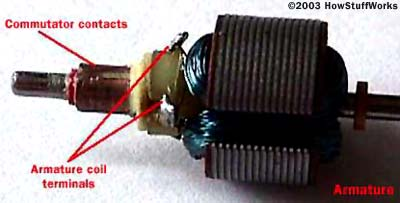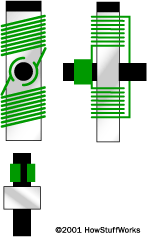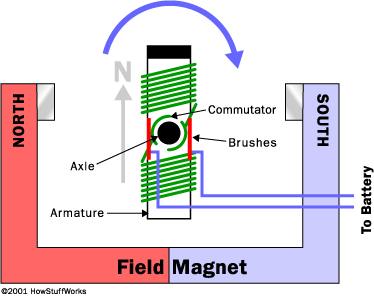A simple two-pole DC
electric motor has six parts, as shown in the
diagram below:
An electric motor uses magnets to create motion. Opposites attract and likes repel. So if you have two bar
magnets with their ends marked "north" and "south," then the north end
of one magnet will attract the south end of the other. On the other
hand, the north end of one magnet will repel the north end of the other
(and similarly, south will repel south). Inside an electric motor, these
attracting and repelling forces create rotational motion.
In the above diagram, you can
see two magnets in the motor: The armature (or rotor) is an
electromagnet, while the field magnet is a permanent magnet (the field
magnet could be an
electromagnet as
well, but in most small motors it isn't in order to save power).
More Parts
The axle holds the armature and the commutator. The armature is a set of
electromagnets,
in this case three. The armature in this motor is a set of thin metal
plates stacked together, with thin copper wire coiled around each of the
three poles of the armature. The two ends of each wire (one wire for
each pole) are soldered onto a terminal, and then each of the three
terminals is wired to one plate of the commutator. The figures below
make it easy to see the armature, terminals and commutator: The final
piece of any DC electric motor is the field magnet. The field magnet in
this motor is formed by the can itself plus two curved permanent
magnets: One end of each magnet rests against a slot cut into the can,
and then the retaining clip presses against the other ends of both
magnets.

Electromagnets and Motors
To understand how an electric motor works, the key is to understand how
the
electromagnet
works. An electromagnet is the basis of an electric motor. The key to an electric motor is
that the field of the electromagnet flips. The
flip causes the electromagnet the electric motor
to spin freely.
Armature, Commutator and Brushes
|

Armature |
The armature is an electromagnet made by coiling thin wire around
two or more poles of a metal core. The armature has an axle, and
the commutator is attached to the axle. The "flipping the
electric field" part of an electric motor is accomplished by two parts:
the commutator and the brushes. The diagram at the right
shows how the commutator and brushes work together to let current flow
to the electromagnet, and also to flip the direction that the electrons
are flowing at just the right moment. The contacts of the commutator are
attached to the axle of the electromagnet, so they spin with the magnet.
The brushes are just two pieces of springy metal or carbon that make
contact with the contacts of the commutator.
Putting It All Together
When you put all of these parts together, what you have is a complete
electric motor: In this figure, the armature winding has been left out
so that it is easier to see the commutator in action. The key thing to
notice is that as the armature passes through the horizontal position,
the poles of the electromagnet flip. Because of the flip, the north pole
of the electromagnet is always above the axle so it can repel the field
magnet's north pole and attract the field magnet's south pole.
these parts together, what you have is a complete electric motor:
Motors Everywhere!
Look around your house and you will find that it is filled with electric
motors. Here's an interesting experiment for you to try: Walk through
your house and count all the motors you find. Starting in the kitchen,
there are motors in:
-
The fan over the stove and in
the
microwave oven
-
The dispose-all under the sink
-
The blender
-
The can opener
-
The
refrigerator -
Two or three in fact: one for the compressor, one for the fan inside
the refrigerator, as well as one in the
icemaker
-
The mixer
-
The
tape player in
the answering machine
-
Probably even the clock on the oven
In the utility room, there is an
electric motor in:
Even in the bathroom, there's a motor
in:
Your car is loaded with electric
motors:
Plus, there are motors in all sorts
of other places:
-
Several in the
VCR
-
Several in a
CD player or
tape deck
-
Many in a
computer (each
disk drive has
two or three, plus there's a fan or two)
-
Most
toys that move
have at least one motor (including Tickle-me-Elmo for its vibrations)
-
Electric clocks
-
The garage door opener
-
Aquarium pumps



